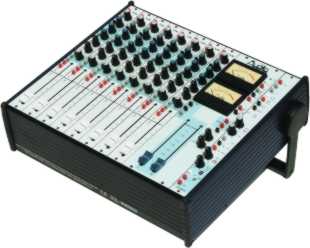AD-147 Mercury Mezclador de 6, 8, 10 y 12 Entradas – 2 Salidas y 2 Auxiliares
Continuando el enorme éxito del mezclador portátil de 4 salidas AD-146, el diseño de la AD-147 se orientó a poder escoger varios formatos manteniendo la misma calidad de construcción, componentes y rendimiento. La sección de salida se ha dividido en dos grupos principales controlados por faders lineales de 100 mm. y 2 envíos auxiliares con control rotatorio.
Potenciómetros panorámicos enrutan la señal principal, mientras que los Auxiliares tienen controles individuales conmutables entre Pre y Post Fader, pudiendo así mismo desconectarse. Esto implica que el mezclador puede usarse casi como una unidad de 4 grupos. El uso de balanceado electrónico en entradas y salidas produce un beneficio de costo y peso considerable. Otros ahorros en el método de construcción producen una reducción de costes de un 20%-25% respecto al mismo tamaño de chasis de la AD-146. Se han incluido en este nuevo mezclador de la familia de Audio Developments la mayor parte de las características que han hecho tan popular al AD-146.
- The AD147 addition to the 140 series of mixers uses the same ultra low noise circuitry and customized aluminum extrusions that have rightly earned for the range its reputation for clean, crisp audio and reliability.
- The AD147 has been developed for discerning engineers who require Audio Developments' build and transparent sound quality allied with the simplicity of its predecessor - PICO.
- The AD147 incorporates the M-S facilities that are now much appreciated by Audio Developments' customers. Many recordists are aware of the advantages Blumlein's M-S microphone techniques have over all other microphone techniques - even when recording in the L-R domain.
- The AD147 has four mixing busses that enable mixing and/or recording to be performed in the L-R and M-S domains simultaneously. Matrix amplifiers may be switched into the main L-R output and across auxiliary 1 & 2 outputs.
- The AD147 takes advantage of the lower noise-floor of modern digital recorders - the limiter slope ratio is a gentle 7:1, thereby reducing distortion and making the artifacts normally associated with limiters much less noticeable or objectionable.
- The AD147 presents all its input and output connectors on one surface of the case and in-line with the corresponding module. The connector panel is labeled in order that it may be read from the front of the mixer. The integral carrying handle may also be used to support the mixer at a comfortable working angle.
- The AD147 inputs, main and auxiliary outputs are electronically balanced on XLRs with an option of transformer balancing on outputs. Separate connectors are used for microphone and line-level inputs: such is the isolation, both input signals may remain connected at all times. Monitor left, right and headphones together with stereo auxiliary return left and right appear on standard jacks. A 6-pin XLR carries two-way conversation between the mixer and an Outstation - boom operator, director etc.
- The AD147 receives its power from 10 x C cells fitted internally - the battery housing adding great strength to the casework. Alternatively, the mixer may be powered from an external 12-15v DC source.
- AD100-015 power supply unit is designed to drive the mixer and, at the same time, charge a set of nickel cadmium batteries -when fitted.
- The AD147 possesses features and facilities rarely encountered in a mixer of its type and size: metering of all signal paths; matrix amplifier and balance/width control on monitor circuits; continuous or interrupted.
- REFERENCE 0dB = 775mV at 1kHz unless otherwise stated
- MAX GAIN: MIC 85dB / LINE 50dB
- MAX INPUT LEVEL: MIC @ MAX GAIN -42dB MIN GAIN 0 / LINE @ MAX GAIN -7dB MIN GAIN +30dB / RETURN (STEREO & TB) 24dB
- INPUT IMPEDANCE: MIC >1k5R / LINE >10kR / RETURN >100kR (STEREO & TB)
- MIC POWERING 48V PHANTOM and 12V TONADER
- MAX OUTPUT +24dBm (600R LOAD) L/R & AUX 1/2 ELEC. BALANCED / +18dBm (600R LOAD) MONITOR 1/2 & TB SEND UNBALANCED OUTPUT
- IMPEDANCE <60R L/R & AUX 1/2 / <20R MONITOR 1/2 / <20R TB SEND
- FREQUENCY RESPONSE +0; -1dB 20Hz to 20kHz MAIN SIGNAL & AUXILIARY PATHS +0; -1.5dB 20Hz to 20kHz MONITOR PATHS
- EQUALISATION 3 BAND: LF; ±10dB @ 100Hz ±15dB MAX @ 30Hz VARIABLE TURNOVER / MF; ±15dB @ 2k8Hz Q = 1.2 PEAK & DIP RECIPROCAL / HF; ±10dB @ 10kHz ±15dB MAX @ 30kHz
- VARIABLE SLOPE: HIGH-PASS FILTER -3dB @ 110Hz 12dB/OCTAVE (REFER TO CURVE)
- HARMONIC: DISTORTION <0.03% @ 1kHz 0dBm OUTPUT / <0.15% @ 40Hz to 20kHz +15dBm OUTPUT
- OVERLOAD INDICATOR ILLUMINATES AT +15dB AT THE PRE- FADER POINT
- CROSSTALK <-70dB 40Hz to 15kHz INTERCHANNEL & INTERGROUP
- NOISE: MIC <-126dB EIN 20Hz to 20kHz 200R SOURCE (WITH RESPECT TO THE INPUT) / LINE <70dB SNR 20Hz to 20kHz
- LIMITER THRESHOLD +8dB
- RATIO 7 : 1
- ATTACK 2 SETTINGS INTERNALLY SWITCHABLE 1 - 4ms; 2 - 0.8ms
- RELEASE 2 SETTINGS INTERNALLY SWITCHABLE 1 - 250ms; 2 - 80ms
- POSITION 1 IS SET AT FACTORY
- POWERING EXTERNAL AD100-015 POWER SUPPLY UNIT +14V DC, 4-PIN XLR
- 3W (WITHOUT MICROPHONE POWERING)

